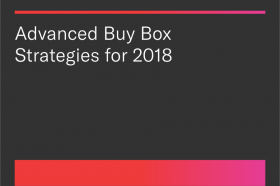Resources - Blog
Maximize Your Buy Box Potential for 2018

Stay on top of the latest e-commerce and marketplace trends.
In the latest webinar to come out of our Ask the Amazon Experts series, we highlighted the must-implement strategies for high-volume sellers looking to take their Amazon business to the next level.
Feedvisor’s CTO and Co-founder Eyal Lanxner leads Feedvisor’s in-house team of data scientists who developed our repricing algorithm for the Amazon Buy Box, illustrating his expertise surrounding Amazon’s ever-evolving marketplace, Buy Box dynamics, and price changes.
His team has analyzed several tens of billions of data points per day over the past seven years to help online sellers better understand notions and insights while operating a business on Amazon. Eyal mentioned an industry-circulating quote that states, “The Buy Box on Amazon is not the most important thing, it’s actually the only thing.” This powerful statement is nearly 100% true – with almost 80% of Amazon’s sales taking place within the Buy Box, it’s imperative for sellers to show up in that prime position in order to positively impact both sales and profit.
Seller Attributes
To begin, price is not the only factor that Amazon’s algorithm analyzes when dictating a Buy Box winner. There are other attributes (these vary in importance) such as fulfillment method, item condition, shipping time, seller feedback count, seller feedback score, order defect rate, late shipment rate, on time delivery, cancellation rate, and refund rate.
It is in fact possible to beat Amazon to the Buy Box and it can be accomplished by aiming to perfect at least one of these areas: better availability, faster shipping time, and a better/lower price. It is also common that Buy Box winners win the space with higher prices than their competitors – they simply maintain better performance metrics when it comes to availability or shipping.
Business Goals and Constraints
It is crucial for Amazon sellers to establish their own strategies according to their specific business goals – it is not one size fits all. They need to interweave their Buy Box strategies with their business goals so that these two variables can work together during daily business processes.
Competing for the Buy Box starts with improving purchasing terms against suppliers, enhancing seller attributes, and optimizing fulfillment methods. One fulfillment method that has surged over the last year is SFP, or Seller-Fulfilled Prime, where sellers fulfill orders from their own facilities but get the Prime “stamp” on these products.
Sellers need to know where they want to fulfill via SFP on a regional level and also need to know where their competition and demand is coming from. The stronger your product listings are on Amazon, the more room you have to compete for the Buy Box.
Next, if a seller’s main goal is maximizing profits, they need to be able to pinpoint exactly what price will drive those profits. Additional goals and constraints that sellers should take into consideration are a minimum margin constraint, a minimum or maximum velocity, or an out of stock date that they want inventory liquidated by. In order to look at all of these processes with a “big picture” perspective, sellers need to take all costs into consideration – cost of goods, advertising costs, storage costs, shipping and handling costs, referral and closing fees, returns fees, and any additional above and beyond costs.
Sellers also need to be able to account for shifts in supply and demand levels. Depending on whether product is or isn’t replenishable, if inventory levels are high or low, or if demand is trending up or down will help sellers be able to apply more or less aggressive pricing strategies.
Price Wars
Amazon sellers need to be able to manage Amazon price wars or fear being ousted by the competition. Price wars tend to occur with products that have a higher monetary value and more competition. A price war is defined as “commercial competition characterized by the repeated cutting of prices below those of competitors” and in this case the price-cutting is in efforts to win the Buy Box.
The majority of price wars today last up to four hours, with about 30% lasting one to two hours. Nearly 92% of price wars today involve two distinct competitors, and almost 8% involve three competitors. Eyal included three strategies to manage price wars:
Learn the arena
Understand the realistic Buy Box share that you need to target and maintain a handle on effective versus ineffective competition and who you really need to look out for on the marketplace. Know that Amazon’s dynamic environment changes frequently so you need to be fluid in your ability to adjust to new policies or performance standards while still maintaining your brand and adhering to your business goals.
Know your competitors
Research your competitors’ repricing methods and how low they can go with their estimated floor price. Differentiate yourself from your competitors by engaging with your customers and getting involved in their buying process to make it the most enjoyable experience. This will foster their trust and recurring engagement which will eventually become customer loyalty.
Be a market maker
Be proactive in your approach. Increase price levels in your arena whenever possible, assuming that others will follow you. Interestingly, nearly one third of price wars are actually reverse price wars meaning that the price is increased rather can decreased. If successful, this can shift the entire market for a product upward.
Technology
One of the core challenges that sellers fact on Amazon is that everything is constantly changing – competitors’ characteristics and ratings, competitors’ prices, competitors’ tools and reporting techniques, and importantly, Amazon’s Buy Box algorithm. If you want to optimize your performance, you need to be able to adapt to these changes on the fly as they take place.
You need to better understand your competitive edge (aside from price) in order to win the Buy Box at the highest price, maintaining your margins. When it comes to repricers, two main options exist: rule-based repricers and algorithmic/AI repricers. The rule-based technology is set manually, prone to human bias, focuses on lowering prices, is not optimized for maximizing profit, and is slow to capitalize on constantly changing market conditions.
With a machine-learning, data-driven algorithmic repricer, prices are set automatically, drawn from and based on big data (which leads to much more intelligent conclusions), the data includes statistical methods for maximizing your profits, and the prices adapt to changing market conditions and Amazon’s algorithm. AI technologies adapt to changing market conditions through machine-learning models – each model analyzes different subsets of data to gain insights, patterns, and trends and all of the models are eventually combined through machine-learning until a final pricing decision is made.
A Look into the Future
Feedvisor analyzed price changes within the Buy Box and could see that over time there has been an increase in price changes, typically year over year. We see about five billion price changes each day and this will definitely continue to increase in the future.
The name of the game will be swiftly navigating Amazon’s marketplace and using the proper tools to compete in that marketplace in order to effectively maximize your business goals and keep winning the Buy Box.
To listen to the full Ask the Amazon Experts: Advanced Buy Box Strategies for 2018 webinar, click the link below.
Learn what Feedvisor can do for your business.
When you partner with Feedvisor, you automatically receive access to our true, AI-driven technology and hands-on team of e-commerce experts. Contact one of our team members today to learn more about our end-to-end solution for brands and large sellers on Amazon, Walmart, and e-marketplaces.



